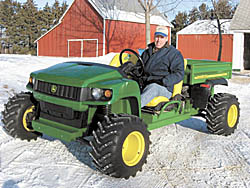
John Thuerauf was looking for something a little more sporty than a factory-built Deere Gator, so he decided to build his own.
The "IntimiGator", as he calls it, is built largely from car parts. It's powered by a fuel-injected, 1.6-liter Toyota Corolla car engine with about 110 hp and also has the car's 5-speed manual transmission. The steering wheel is off a Chevy Lumina.
"Most people who see it think Deere built it and only realize it's unique after they take a closer look," says the Plum City, Wis., man. "It's slightly bigger than a real Gator. I finished building it two years ago, with about 90 days of construction time. I built it because I wanted something a little more fun to drive. I regard it as a cross between a dune buggy and a farm utility vehicle. It has quick acceleration with a top speed of up to 70 mph.
"The only parts from Deere are the plastic pieces on front, the hood, fenders, grille and dash."
Thuerauf says his model is a little larger and has more power than a conventional Gator (the factory Gator has only about 20 hp.) It also has 4-wheel power steering. The rear wheel steering is operated independently by a 12-volt gear drive electric motor. It's controlled by a toggle switch mounted between the seats. If I want I can turn both axles in the same direction, or crab steer. It's a neat feature but is mostly a novelty, as most of the time I just use the front wheel steering."
His rig has larger tires with more aggressive tread, better suspension, and rear wheel drive instead of front as on the Gator. It rides on 24-in. high, 12-in. wide lug-type wheels off a Kubota compact tractor. The seats are out of the Toyota and are fully adjustable. He got his mother-in-law to recover them in yellow vinyl.
Thuerauf says he built the machine because he was looking for a farm utility vehicle with a little more "get-up-and-go", and at the same time save money. "In the Midwest, it's fairly easy to find inexpensive cars with good drivetrains because their values depreciate substantially as the body begins to oxidize.
There is a 2 to 1 chain reduction drive between the differential and each of the two rear axles. This results in a much better low-end speed, allowing the machine to be much more maneuverable in tight places and at the same time doubles the torque.
The rig has a homemade dump box that's designed to be manually tilted back, providing easy access to the engine. The tailgate has a pickup-style latch and lever. The radiator mounts under the hood and is cooled by a 12-volt fan.
"It was fun to build and is even more fun to drive," says Thuerauf. "It has proven to be very reliable. I use it for projects around our farm as well as to entertain visitors. It has 4-wheel independent suspension which gives it a smooth ride on my grass waterways and buffer strips. The wheel spacing is 60 inches so it works well for checking my crops. When my two young daughters, ages 6 and 2, hear it start up, they're always quick to run outside, looking for a ride.
"I set the engine on a stand and started building a steel frame around it. The gas tank, which I bought new, mounts behind the engine. I mounted a high pressure fuel pump inside the gas tank to supply fuel to the car's fuel injected engine."
Thuerauf paid for the four wheels. "I had to modify the rims to fit the car's brake assembly," he notes.
